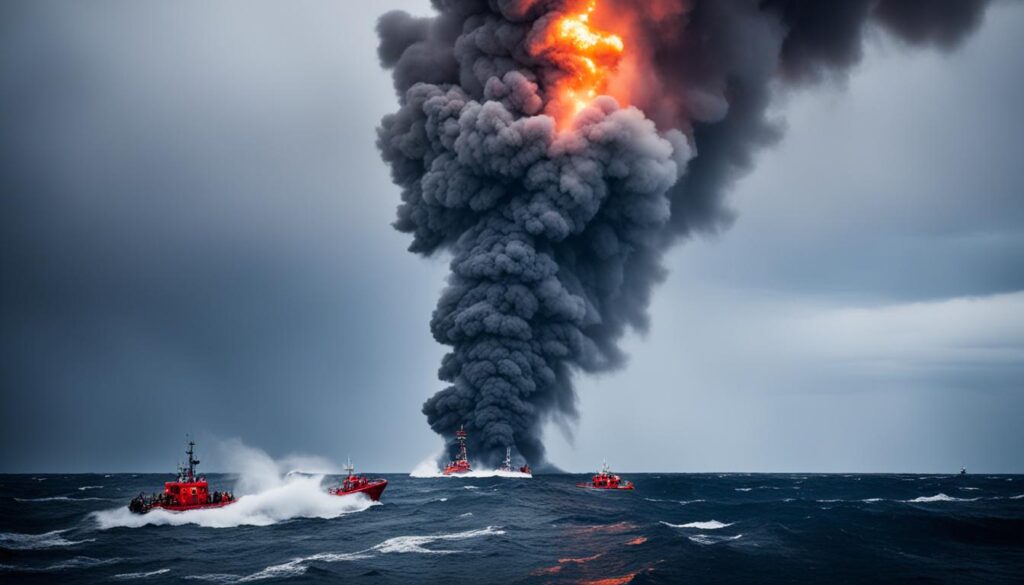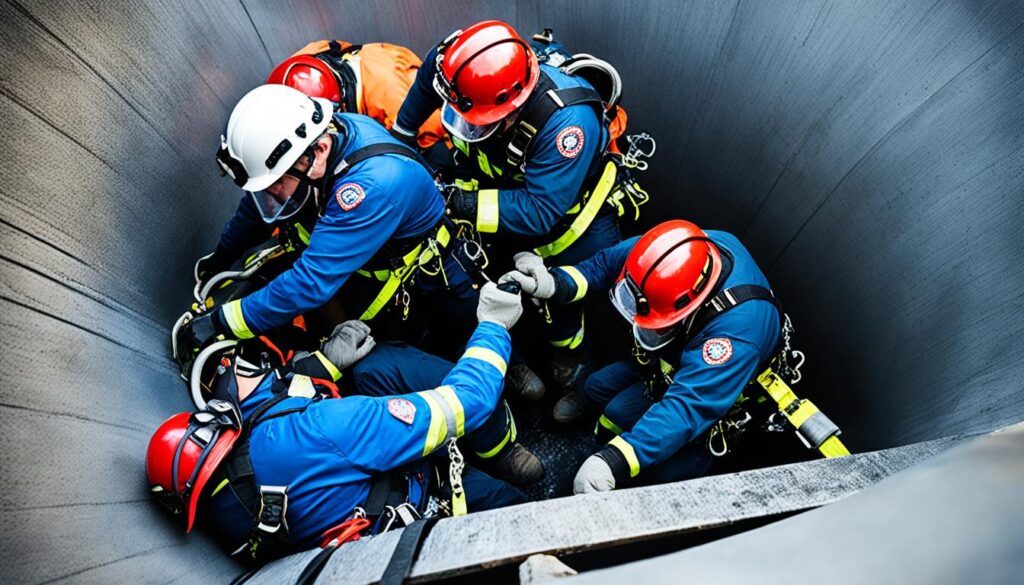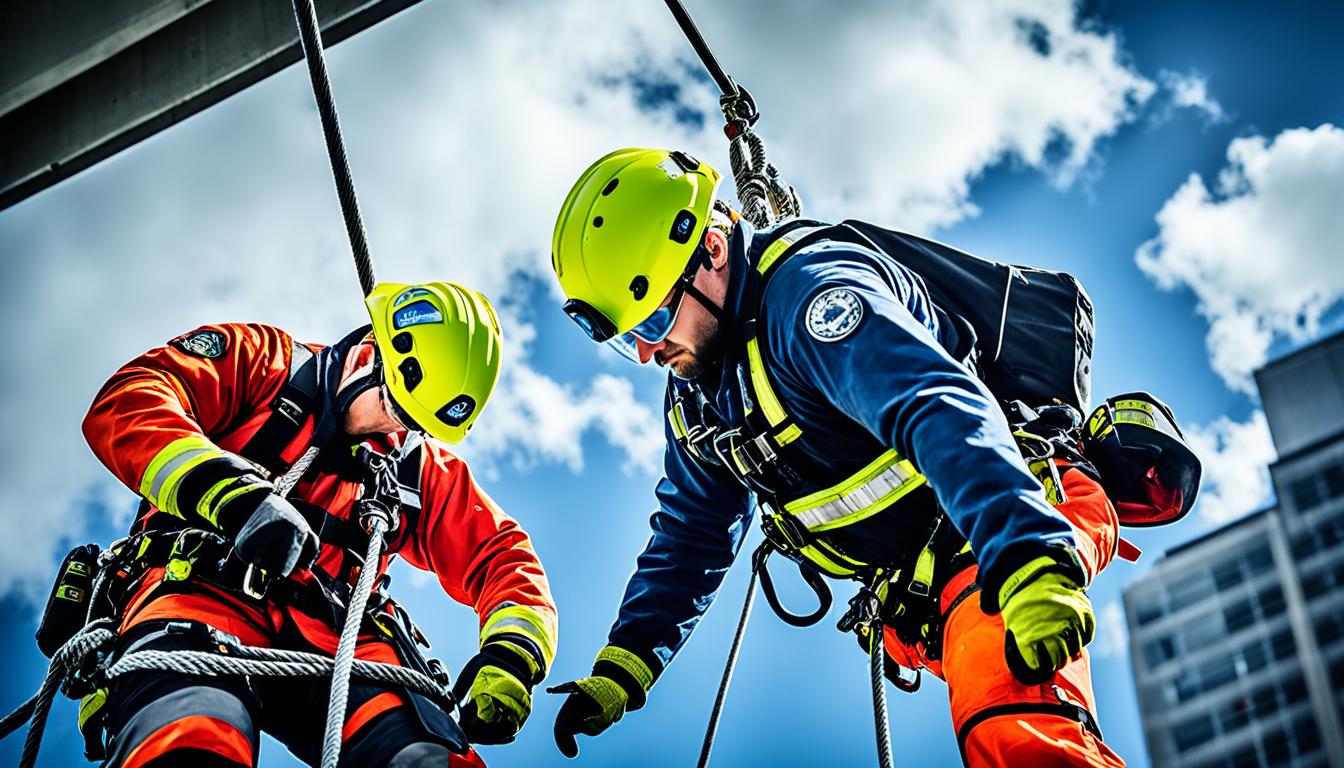Welcome, I’m thrilled to bring you this essential guide on rescue operations and safety. We’ll look into techniques for better rescue operations and safety in things like confined spaces. If you’re a safety pro, emergency responder, or just interested in being prepared, this guide is perfect for you.
Rescue operations and safety rules are key for being ready in emergencies and managing crises well. They help lower risks, keep workers safe, and save lives. We’ll talk about the critical role of confined space rescue, using communication systems, rescue drills, cleaning up afterward, and more. Let’s together explore how to make work safer for everyone.
Key Takeaways:
- Rescue operations and safety rules are vital for emergency preparedness and crisis management.
- Confined space rescue needs special skills and training because it’s tough.
- Ten essential techniques include making a solid rescue plan, checking risks, and giving the right equipment and training.
- Good communication and ongoing checking are key for keeping workers safe during rescue operations.
- Regular rescue drills and making sure the air is clean keep the workplace safe in confined spaces.
Importance of Confined Space Rescue
Confined spaces present unique risks which make rescue efforts vital. It’s critical to focus on rescue in these areas to keep workers safe. Without the right steps and training, entering these spots is very dangerous. So, let’s look at why rescuing from confined spaces is key and the risks if we ignore these essential steps.
Understanding the Hazards of Confined Spaces
Tanks, vessels, and bins often have limited ways in and out. They also might not have enough oxygen and could be dangerous. Workers can get stuck or face serious harm. Saving them is hard because of these tight spaces.
“Rescuing workers from confined spaces demands specialized skills and knowledge about rescue techniques to mitigate the associated risks.”
The Importance of Specialized Training
Rescue in confined spaces needs more than basic medical skills. Rescuers should know how to use special gear and methods to get workers out safely. They also must be able to spot dangers upfront, wear the right protective gear, and communicate well.
By teaching detailed rescue tactics, organizations make sure their teams are truly ready. These teams can act fast and do their jobs well in tough times.
Protecting Worker Safety
Keeping workers safe is the main goal of confined space rescue. Following the right rescue plans shows a company cares about its people. Quick and well-done rescues cut down on the risk of serious harm or death.
A safe place to work boosts how people feel and work. It makes them want to keep doing their best, knowing their safety is important to their bosses.
The Legal and Ethical Responsibility
Ensuring workers are safe in tight spots is both a legal duty and the right thing to do. OSHA and other groups set rules to keep all workers safe.
By obeying these rules and having good rescue plans, companies don’t just dodge fines. They also protect their people and show they care about safety.
Confined space rescue is key for keeping workers safe. Bad training and ignoring the right steps can be deadly. By focusing on rescue and training well, companies look after their workers. They also build a place where safety comes first, meeting their legal and moral duties.
Ten Essential Techniques for Confined Space Rescue
To have successful confined space rescues, ten key techniques are essential. They cover the necessary parts like a good plan, risk checks, the right gear, and having the team well-trained. These are crucial for making rescues safe and effective.
- Develop a comprehensive rescue plan: Every successful rescue starts with a solid plan. It outlines what everyone needs to do, their roles, and how to talk to each other. A good plan is key to handling emergencies well. (Source: Rescue Operations Handbook)
- Evaluate the risks involved: Understanding the dangers before going into a confined space is a must. It helps to spot risks and put safety measures in place. This includes checking the air quality, dangers in the space, and harmful substances. (Source: Occupational Safety and Health Administration)
- Use proper equipment: A rescue team must have the right gear to be safe and do their job well. This includes things like safety gear, harnesses, radios, lights, and special tools for tight spaces. (Source: National Fire Protection Association)
- Provide training and education: Teaching rescue teams is crucial. They need to know how to act fast and safe in a confined space. Training, practice, and study keep them sharp for emergencies. (Source: Confined Space Entry Training Manual)
- Establish effective communication: Communication must be clear and fast during a rescue. Good systems help everyone talk and share info easily. This teamwork keeps the rescue safe and on track. (Source: Confined Space Rescue Communication Systems Guide)
- Perform continuous monitoring: Keeping an eye on the space at all times is necessary. Check the air, the temperature, and how the team is doing. This helps to spot problems early and keep everyone safe. (Source: Emergency Response and Preparedness Handbook)
- Coordinate with other emergency response teams: Sometimes, multiple teams must work together. This makes the rescue more effective. They share resources and skills to save lives. (Source: Emergency Response Coordination Protocol)
- Utilize specialized rescue techniques: Special situations sometimes need unique ways to rescue people. These can include certain ways to move or reach people that the team must know well. (Source: Confined Space Rescue Techniques Manual)
- Regularly inspect and maintain equipment: Checking and caring for rescue equipment is vital. This involves looking at radios, rope, breathing gear, and everything else. It ensures everything works when it’s needed. (Source: Equipment Maintenance and Inspection Guidelines)
- Document and learn from rescue operations: Understanding what went right and what went wrong in a rescue helps us get better. Writing down the details helps teams improve for next time. (Source: Post-Rescue Operation Evaluation Framework)
Following these techniques makes confined space rescues safer and more effective. They stress the importance of careful planning, checking risks, using proper gear, and having skilled teams. This helps lower the dangers of confined space work and keep people safe.
Communication and Continuous Monitoring in Rescue Operations
In rescue operations inside small spaces, good communication and steady monitoring are crucial. They both help keep workers safe and speed up how fast we can help them in emergencies.
“Communication is the lifeline that connects us during rescue operations, allowing us to coordinate efforts and provide crucial information to those inside confined spaces.”
Having a solid way to talk to each other is key in rescue work. We set up tools and plans for talking clearly between teams and those inside the tight spots. Different gadgets and methods exist, each with its own good points.
Two-way radios or walkie-talkies are some of these tools. They allow teams to talk back and forth right away, giving updates fast. Easy to use and straightforward, they help keep messages clear between rescuers and trapped workers.
Other gear like headsets that let you use your hands and intercoms might also be helpful. The choice depends on what the situation calls for and how complicated things are.
Checking in regularly is just as important. By keeping an eye on what’s happening in the small spaces, teams can act fast when something goes wrong. This helps make sure workers are okay and lets rescuers make smart choices.
We can watch over things with cameras, sniff for bad gases, and spot movement. With these tools, we get updates live, letting us figure out what to do and do it right away.
“Continuous monitoring ensures that rescue teams are alerted to any distress signals or hazardous conditions, enabling them to respond promptly and effectively.”
Next, we’ll explore the kinds of gear and methods we often use in rescues to talk and keep an eye out:
| Communication Devices | Monitoring Techniques |
|---|---|
| Two-way radios | Video surveillance |
| Hands-free headsets | Gas detectors |
| Intercom systems | Motion sensors |

Rescue Drills and Ventilation in Confined Spaces
Ventilation and rescue drills are key for worker safety in tight spots. They help create a safe zone and get ready for if things go wrong.
Importance of Rescue Drills
Having regular rescue drills helps workers get ready for the unexpected. These simulation practice sessions allow workers to learn about using equipment and working together in a rescue. This ensures they know what to do and can spot any issues before they become big problems.

Importance of Ventilation Systems
Good air is essential in small, enclosed areas. Ventilation removes dangerous fumes and keeps air fresh. This makes work more comfortable and safe.
Well-designed systems keep the air clean and stop dangerous gas buildups. This cuts down on the chance of accidents, keeping workers out of harm’s way.
Establishing Multiple Entry Points
Having more than one way in or out is a big plus in a rescue. It means rescue teams can get to people more easily. This is even more important when the situation is complex.
I was involved in a confined space rescue operation where the only entry became blocked. We had a backup entry point. It helped us rescue the trapped workers quickly and safely.
Extra entry points offer rescue teams more options. They’re critical in case of emergencies or if the main way gets blocked. This smart planning makes rescues smoother and workers safer.
These steps – drills, good air, and multiple entries – all keep workers in confined spaces safe. Regular drills build workers’ skills for emergencies. Ventilation removes harmful substances. And extra ways in and out make rescue jobs easier. It all adds up to a safer workplace.
Decontamination Procedures and Safety Measures
Proper decontamination and safety in confined space rescue are extremely important. They stop hazardous materials from spreading. They also keep workers safe.
Decontamination is a process that removes harmful elements. It means cleaning the site and anyone in contact. This lessens the chance of anyone getting sick.
Safety steps are critical during decontamination. Rescue teams and anyone involved must wear the right gear. This includes hazmat suits, gloves, masks, and goggles.
Following a clear decontamination process is key. It involves evaluation, containment, and safe waste disposal. This keeps rescue areas safe and reduces health risks.
Decontamination Procedures
Now, let’s see the steps for decontaminating confined spaces.
- Evaluation: First, understand the contamination before cleaning. Assess what’s there and how bad it is to choose the right decontamination methods.
- Containment: Next, set up a special decontamination place. It keeps hazardous materials from spreading. This spot should have showers and cleaning stuff.
- Personal Decontamination: People who touched the dangerous stuff need to clean up too. They should take off dirty clothes and wash well. Rinse off to get rid of any toxins.
- Equipment Decontamination: Don’t forget to clean the tools and gear used. This stops any old dangers from coming back. Clean ropes, harnesses, and radios well.
- Waste Disposal: Getting rid of the waste safely is crucial. Follow the local rules to avoid harming the environment. Dispose of the dangerous stuff correctly.
Safety Measures
Aside from cleaning, safety for the team is key. Here’s how to keep everyone safe:
- Training and Education: Everyone in the team should know their rescue role. Train them well in decontamination and safety. This prepares them for emergencies.
- Proper Ventilation: Good airflow is a must. It keeps the air fresh and hazardous levels low. Ventilation aids in a safer working atmosphere.
- Regular Equipment Inspection: Check gear often to avoid accidents. Find and fix any problems fast. Don’t use faulty equipment to stay safe.
- Regular Safety Drills: Practice safety often. This helps perfect rescue and cleanup steps. It also shows if more training or gear is needed.
By doing thorough decontamination and sticking to safety rules, rescue teams stay safer. This is especially true in confined spaces.
| Types of Hazardous Substances | Health Risks | Protective Measures |
|---|---|---|
| Chemical Substances | Respiratory issues, skin irritation, chemical burns | Use appropriate PPE, establish proper ventilation, follow proper decontamination protocols |
| Biological Agents | Infections, allergies, respiratory issues | Wear biohazard suits, masks, and gloves, follow stringent decontamination procedures |
| Radiation | Cellular damage, radiation sickness, increased cancer risk | Use radiation-resistant suits and equipment, limit exposure time, follow decontamination procedures for radioactive materials |
| Toxic Gases | Respiratory distress, asphyxiation, loss of consciousness | Wear gas masks and appropriate PPE, ensure proper ventilation, use gas detectors |
Conclusion
Rescue missions and safety plans form the foundation of how different areas handle crises. By using the ten key methods highlighted in this guide, businesses can make their rescue missions safer and more effective.
Key to a successful rescue is good communication. Having strong communication systems lets teams act quickly and safely. This protects the people in dangerous places. Watching for distress signals is also important. It helps spot risks early, starting rescue missions sooner.
It’s also vital for companies to make safety a top priority. They should teach their workers how to spot risks and react. Giving them the right tools and training will keep them safe during rescues.
In the end, good safety procedures, constant monitoring, and excellent training are critical for rescue work. These efforts create a safe place to work, stop accidents, and rescue people in danger.
FAQ
Why are rescue operations and safety protocols important?
Rescue operations and safety protocols are key. They help people during emergencies. This keeps workers safe and improves how rescues happen in many places.
What are confined spaces, and why is confined space rescue important?
Confined spaces have limited ways in or out. This makes it hard for people to get out when something goes wrong. A specially trained rescue team is needed to help in these places.
What are the ten essential techniques for confined space rescue?
To rescue someone in a confined space, certain steps must be followed. These include making a detailed rescue plan and checking for dangers. Providing training and proper equipment is crucial. It’s also key to have good communication and keep an eye on the situation. Doing practice rescues, having clean air, and following safety steps are also very important.
Why is effective communication important in rescue operations?
Good communication saves lives in rescue work. It lets everyone know what to do and where to be. This includes using technology and watching for signs of trouble. These steps help make a rescue successful.
Why are rescue drills and ventilation important in confined spaces?
Rescue drills show workers what to do in a crisis. They also highlight any problems in the rescue plan. Good air through ventilation keeps the space safe. It helps remove dangerous gases or dust.
What are the decontamination procedures and safety measures in confined space rescue operations?
Stopping the spread of harmful things is a big part of rescue work. Decontamination cleans workers and gear to make sure they’re safe. Wearing the right protective gear is a must. This stops anyone from getting hurt by dangerous materials.




